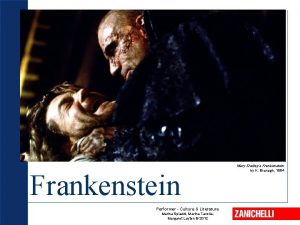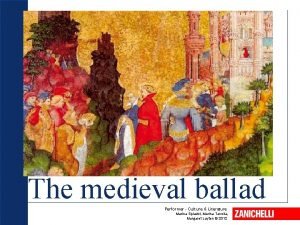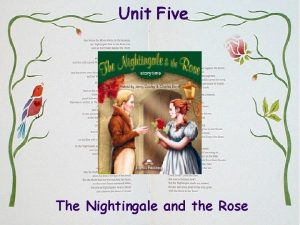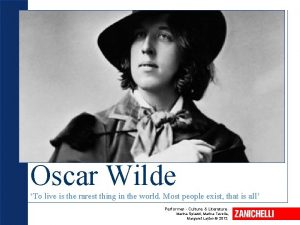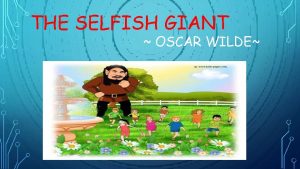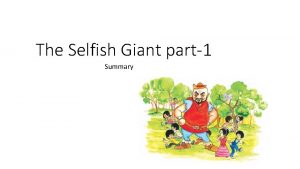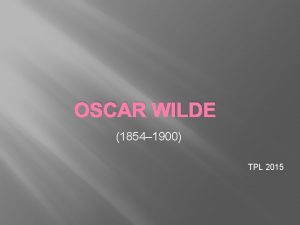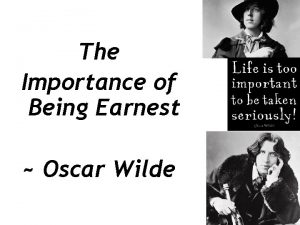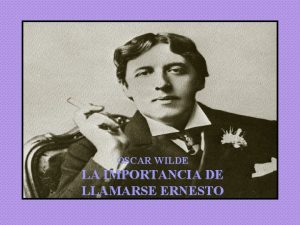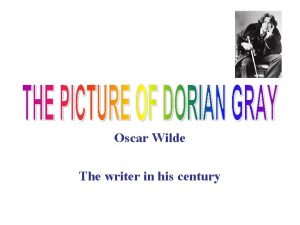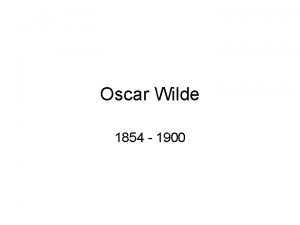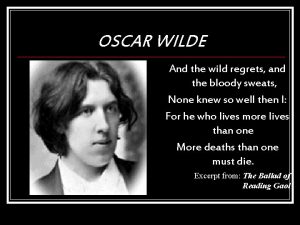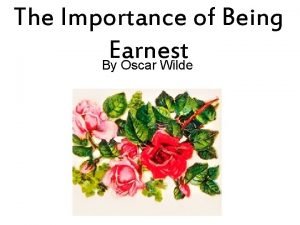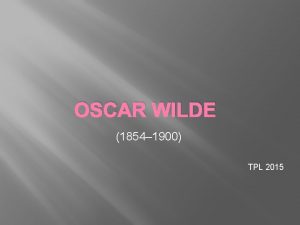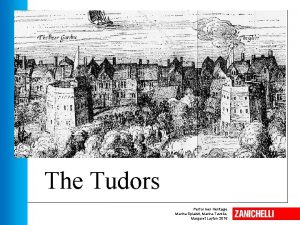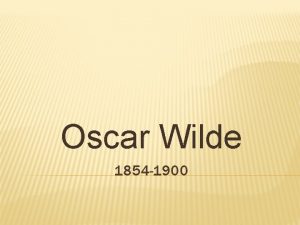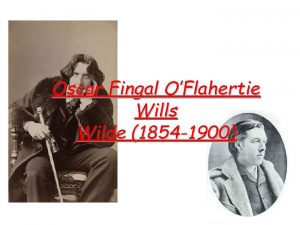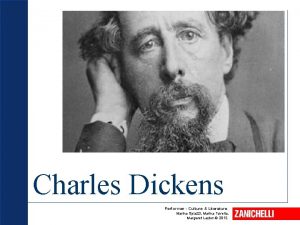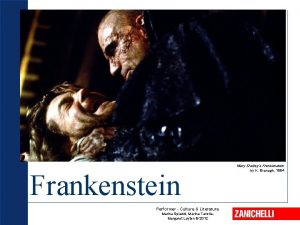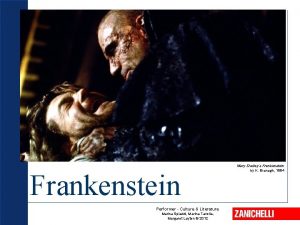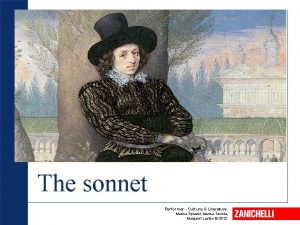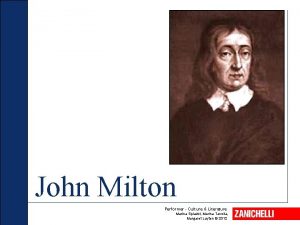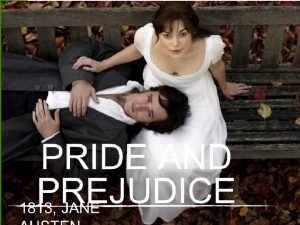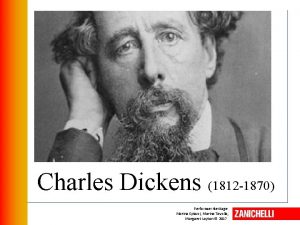Oscar Wilde 1854 1900 Performer Heritage Marina Spiazzi


















- Slides: 18

Oscar Wilde (1854 -1900) Performer Heritage Marina Spiazzi, Marina Tavella, Margaret Layton © 2017

Oscar Wilde 1. Life • Born in Dublin in 1854. • He became a disciple of Walter Pater, theorist of Aestheticism, accepting theory ‘Art for Art’s Sake’. • He became a fashionable dandy. • He was one of the most successful playwrights of late Victorian London and one of the greatest celebrities of his days. • He suffered a dramatic downfall and was imprisoned after been convicted of ‘gross indecency’ for homosexual acts. • He died in Paris in 1900. Performer Heritage

Oscar Wilde 2. A clever talker Some of Wilde’s famous quotations: ‘I have nothing to declare except my genius. ’ ‘Experience is simply the name we give our mistakes. ’ ‘A man can be happy with any woman as long as he does not love her. ’ ‘One should always be in love. That is the reason why one should never marry. ’ ‘Art is the most intense mode of individualism that the world has known’. Performer Heritage Oscar Wilde, 1889.

Oscar Wilde 3. Works • Poetry: Poems (1881), The Ballad of Reading Gaol (1898), originally published under his prison identity, C. 3. 3. • Fairy tales: The Happy Prince and other Tales (1888), The House of Pomegranates (1891), written for his children. • Novel: The Picture of Dorian Gray (1891). • Plays: Lady Windermere’s Fan (1892), A Woman of No Importance (1893), The Importance of Being Earnest (1895), Salomé (1893). Performer Heritage

Oscar Wilde 4. Wilde’s Aestheticism Oscar Wilde adopted the aesthetical ideal: he affirmed ‘my life is like a work of art’. His AESTHETICISM clashed with the didacticism of Victorian novels. • The artist the creator of beautiful things. • Art used only to celebrate beauty and the sensorial pleasures. employed by the artist as raw material in his art: • Virtue and vice ‘No artist has ethical sympathies. An ethical sympathy in an artist is an unpardonable mannerism of style. ’ ‘The Preface’ to The Picture of Dorian Gray Performer Heritage

Oscar Wilde 5. The Picture of Dorian Gray 1890 first appeared in a magazine. 1891 revised and extended. • It reflects Oscar Wilde’s personality. • It was considered immoral by the Victorian public. Performer Heritage

Oscar Wilde 5. The Picture of Dorian Gray Plot and setting • Set in London at the end of the 19 th century. • The painter Basil Hallward makes a portrait of a beautiful young man, Dorian Gray. • Dorian’s desires of eternal youth are satisfied. • Experience and vices appear on the portrait. Performer Heritage

Oscar Wilde 5. The Picture of Dorian Gray • Dorian lives only for pleasures. • The painter discovers Dorian’s secret and he is killed by the young man. • Later Dorian wants to get free himself from the portrait; he stabs it but in so doing he kills himself. • At the very moment of death the portrait returns to its original purity and Dorian turns into a withered, wrinkled and loathsome man. Performer Heritage

Oscar Wilde 5. The Picture of Dorian Gray Main characters • Dorian represents the ideal of youth, beauty and innocence. • Lord Henry Wotton, a brilliant talker, sharp in his criticism of institutions. • Basil Hallward, an intellectual who falls in love with Dorian’s beauty and innocence. He becomes an example of how a good artist can be destroyed in a sacrifice for art. Performer Heritage

Oscar Wilde 5. The Picture of Dorian Gray Narrative technique • The story is told by an obtrusive thirdperson narrator. • The perspective adopted is internal since Dorian’s apparition is in the second chapter. a process of identification between the reader and the character. • The language of the senses is used to describe the settings. Performer Heritage

Oscar Wilde 6. A modern version of Dr Faust • A temptation is placed before Dorian: a potential ageless beauty. • Lord Henry’s cynical attitude is in keeping with the devil’s role in Faust. • Lord Henry acts as the ‘Devil’s advocate’. • The picture stands for the dark side of Dorian’s personality. Performer Heritage

Oscar Wilde 7. The moral of the novel Performer Heritage • Every excess must be punished and reality cannot be escaped. • When Dorian destroys the picture, he cannot avoid the punishment for all his sins death. • The horrible, corrupting picture could be seen as a symbol of the immorality and bad conscience of the Victorian middle class. • The picture, restored to its original beauty, illustrates Wilde’s theories of art: art survives people, art is eternal.

Oscar Wilde 8. The Importance of Being Earnest Wilde’s most enduringly popular play. Performer Heritage

Oscar Wilde 8. The Importance of Being Earnest Plot Performer Heritage • Set in the fashionable Mayfair of London’s West End during the late Victorian era. • The protagonists: two young aristocratic men, Ernest Worthing and Algernon Moncrieff. • Ernest, actually called Jack, was adopted at an early age by a Mr Thomas Cardew. • Jack has invented an alter ego, a younger brother called Ernest who lives in the City. • Humour comes from the characters’ false identities. • Witty dialogues and satire of Victorian hypocrisy.

Oscar Wilde 8. The Importance of Being Earnest Characters • They belong to the aristocratic society. • They are typical Victorian snobs. • They are arrogant, formal and concerned with money. • They are interested only in a materialistic world. • Lady Bracknell embodies the stereotype of the Victorian English aristocratic woman. Performer Heritage

Oscar Wilde 8. The Importance of Being Earnest Wilde’s new comedy of manners • A new sort of Restoration comedy of manners. • The problems of Wilde’s age are reflected in witty remarks. • This comedy is a mirror of the fashionable and corrupted world of the Victorian audiences. Alana Brophy and Luke Barats in The Importance of Being Earnest, April 2005. Performer Heritage

Oscar Wilde 8. The Importance of Being Earnest The nature of marriage • Marriage is one of the main concerns of the characters in the play. • Wilde makes fun of the institution of marriage. • Marriage is seen as a hypocritical and absurd practice, a tool for achieving social stature. Performer Heritage

Oscar Wilde 8. The Importance of Being Earnest Irony and appearance • The play’s central plot – the man who is both and is not Ernest / earnest – presents a moral paradox. • Earnest, a deliberate misspelling for ‘Ernest’, means earnest, honest. • None of the characters are really truthful. • Characters are used to criticise Victorian prudery. • What Wilde wants us to see as truly moral is really the opposite of earnestness: irreverence. Performer Heritage
 The creation of the monster performer heritage
The creation of the monster performer heritage Medieval ballad zanichelli
Medieval ballad zanichelli Example of petrarchan sonnet
Example of petrarchan sonnet Marina spiazzi
Marina spiazzi Writing style of oscar wilde
Writing style of oscar wilde Oscar wilde zanichelli
Oscar wilde zanichelli Trespassers will be prosecuted selfish giant
Trespassers will be prosecuted selfish giant Selfish lines
Selfish lines Dorian gray portree film
Dorian gray portree film Three types of irony
Three types of irony Oscar wilde ernest
Oscar wilde ernest Dorian grey effect
Dorian grey effect Aestheticism oscar wilde
Aestheticism oscar wilde He did not wear his scarlet coat
He did not wear his scarlet coat The canterville ghost characters images
The canterville ghost characters images Oscar wilde biography
Oscar wilde biography Oscar wilde sebični div
Oscar wilde sebični div Escolho meus amigos
Escolho meus amigos Miss letitia prism
Miss letitia prism
